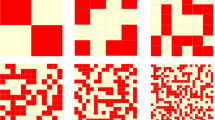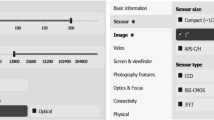Abstract
The global preference formation model identifies several preference formation strategies (i.e., own-based, other-based, or hybrid) that consumers use to select among alternative product offerings. This article examines how consumers’ expertise level (novice vs. expert), their end goals (satisficing vs. optimizing), and product type (search vs. experience product) collectively influence the preference formation strategy likely to be adopted. Results from an experiment indicate that the adoption of a given strategy is influenced by interactions between subjects’ expertise level and their end goals and the product type. Novice satisficers employed a higher proportion of own-based strategies than novice optimizers, but expert satisficers used a lower proportion of own-based strategies than expert optimizers. When compared to novices choosing a search product, novices selecting an experience product used a lower proportion of own-based and a higher proportion of other-based strategies. Similarly, when compared to experts choosing a search product, experts selecting an experienced product used a lower proportion of own-based strategies, but this was accompanied by a higher proportion of hybrid strategies. Implications and directions for future research are discussed.
Similar content being viewed by others
References
Ajzen, Icek and Martin Fishbein. 1980.Understanding Attitudes and Predicting Consumer Behavior. Englewood Cliffs, NJ: Prentice-Hall.
Alba, Joseph W. and J. Wesley Hutchinson. 1987. “Dimensions of Consumer Expertise.”Journal of Consumer Research 13 (March): 411–454.
Anderson, John R. 1980.Cognitive Psychology and Its Implications. San Francisco, CA: Freeman.
Anderson, Rolph E. and Marvin A. Jolson. 1980. “Technical Wording in Advertising: Implications for Market Segmentation.”Journal of Marketing 44 (Winter): 57–66.
Arndt, J. 1967a. “Perceived Risk, Sociometric Integration and Word-of-Mouth in the Adoption of a New Food Product.” InRisk-Taking and Information-Handling in Consumer Behavior. Ed. Donald F. Cox. Cambridge, MA: Harvard University Press, 289–316.
————— 1967b. “The Role of Product-Related Conversations in the Diffusion of a New Product.”Journal of Marketing Research 6 (August): 291–295.
Batra, Rajeev and Michael L. Ray. 1986. “Situational Effects of Advertising Repetition: The Moderating Influence of Motivation, Ability, and Opportunity to Respond.”Journal of Consumer Research 12 (March): 432–445.
Bauer, Raymond A. 1960. “Consumer Behavior as Risk Taking.” InDynamic Marketing for a Changing World. Ed. R. S. Hancock. Chicago, IL: American Marketing Association, 389–398.
————— 1967. “Source Effect and Persuasibility: A New Look.” InRisk-Taking and Information-Handling in Consumer Behavior. Ed. Donald F. Cox. Cambridge, MA: Harvard University Press, 559–578.
Bearden, William O., Richard G. Netemeyer, and Jesse E. Teel. 1989. “Measurement of Consumer Susceptibility to Interpersonal Influence.”Journal of Consumer Research 15 (March): 473–481.
Berning, Carol A. Kohn and Jacob Jacoby. 1974. “Patterns of Information Acquisition in New Product Purchases.”Journal of Consumer Research 1 (September): 18–22.
Bettman, James R. 1979.An Information Processing Theory of Consumer Choice. Reading, MA: Addison-Wesley.
Brucks, Merrie. 1985. “The Effects of Product Class Knowledge on Information Search Behavior.”Journal of Consumer Research 12 (June): 1–16.
Capon, Noel and Marion Burke. 1980. “Individual, Product Class and Task-Related Factors in Consumer Information Processing.”Journal of Consumer Research 7 (December): 314–326.
Chhabra, Surgit and Richard W. Olshavsky. 1986. “Some Evidence for Additional Types of Choice Strategies.” InAdvances in Consumer Research. Volume 13. Ed. Richard J. Lutz. Provo, UT: Association for Consumer Research, 12–17.
Cole, Catherine A. and Siva K. Balasubramanian. 1993. “Age Differences in Consumers’ Search for Information: Public Policy Implications.”Journal of Consumer Research 20 (June): 157–169.
Cox, Donald F. 1967. “Risk Handling in Consumer Behavior—An Intensive Study of Two Cases.” InRisk-Taking and Information-Handling in Consumer Behavior. Ed. Donald F. Cox. Cambridge, MA: Harvard University Press, 34–81.
Curry, David J. and Peter C. Riesz. 1988. “Price and Price/Quality Relationships: A Longitudinal Analysis.”Journal of Marketing 52 (January): 36–51.
Edell, Julie and Andrew Mitchell. 1978. “An Informational Processing Approach to Cognitive Responses.” InResearch Frontiers in Marketing. Ed. Subhash C. Jain. Chicago: American Marketing Association, 178–183.
Ericsson, Anders K. and Herbert A. Simon. 1984.Protocol Analysis: Verbal Reports as Data. Cambridge: MIT Press.
Feldman, Sidney and Merlin Spencer. 1965. “The Effect of Personal Influence in the Selection of Consumer Services.” InMarketing and Economic Development. Ed. Peter Bennett. Chicago, IL: American Marketing Association, 440–445.
Fennell, Geraldine. 1975. “Motivation Research Revisited.”Journal of Advertising Research 15 (June): 23–28.
Fishbein, Martin and Icek Ajzen. 1975.Belief, Attitude, Intention and Behavior: An Introduction to Theory and Research. Reading, MA: Addison-Wesley.
Formissano, Roger A., Richard W. Olshavsky, and Shelly Tapp. 1982. “Choice Strategy in a Difficult Task Environment.”Journal of Consumer Research 8 (March): 474–479.
Furse, David H., Girish N. Punj, and David W. Stewart. 1984. “A Typology of Individual Search Strategies Among Purchasers of New Automobiles.”Journal of Consumer Research 10 (March): 417–431.
Gatignon, Hubert and Thomas S. Robertson. 1991. “Innovative Decision Processes.” InHandbook of Consumer Behavior. Eds. Thomas S. Robertson and Hal H. Kassarjian. Englewood Cliffs, NJ: Prentice-Hall, 316–348.
Hawkins, Del I., Roger J. Best, and Kenneth A. Coney. 1992.Consumer Behavior: Implications for Marketing Strategy. Homewood, IL: Irwin.
Hoyer, Wayne D. 1984. “An Examination of Consumer Decision Making for a Common Repeat Purchase Product.”Journal of Consumer Research 11 (December): 822–829.
Hoyer, Wayne D. and Jacob Jacoby. 1982. “Three-Dimensional Information Acquisition: An Application to Contraceptive Decision Making.” InAdvances in Consumer Research. Volume 10. Eds. Richard P. Bagozzi and Alice M. Tybout. Ann Arbor, MI: Association for Consumer Research, 618–623.
Johnson, Eric and J. Edward Russo 1984. “Product Familiarity and Learning New Information.”Journal of Consumer Research 11 (June): 542–550.
Knoke, David and Peter J. Burke. 1980.Log-Linear Models. Beverly Hills, CA: Sage.
Krugman, Herbert E. 1965. “The Impact of Television Advertising: Learning with Involvement.”Public Opinion Quarterly 29 (Fall): 349–356.
Lichtenstein, Donald R. and Scot Burton. 1989. “The Relationship Between Perceived and Objective Price-Quality.”Journal of Marketing Research 26 (November): 429–443.
Lussier, Dennis A. and Richard W. Olshavsky. 1979. “Task Complexity and Contingent Processing in Brand Choice.”Journal of Consumer Research 6 (September): 154–165.
Maynes, E. Scott. 1976.Decision-Making for Consumers: An Introduction to Consumer Economics. New York: Macmillan.
Miniard, Paul W. and Joel B. Cohen. 1979. “Isolating Attitudinal and Normative Influences in Behavioral Intention Models.”Journal of Marketing Research 16 (February): 102–110.
Miyake, Naomi and Donald A. Norman. 1979. “To Ask a Question, One Must Know Enough to Know What Is Not Known.”Journal of Verbal Learning and Verbal Behavior 18 (June): 357–364.
Moore, William L. and Donald R. Lehmann. 1980. “Individual Difference in Search Behavior for a Nondurable.”Journal of Consumer Research 7 (December): 296–307.
Nantel, Jacques. 1985. “A Study of Some Determinants of Preference Formation Strategies.” Unpublished doctoral dissertation, Indiana University.
Nelson, Phillip. 1970. “Information and Consumer Behavior.”Journal of Political Economy 78 (March/April): 311–329.
—————. 1974. “Advertising as Information.”Journal of Political Economy 81 (July/August): 729–755.
Olshavsky, Richard W. 1985a. “Perceived Quality in Consumer Decision Making: An Integrated Theoretical Perspective.” InConsumer Perception of Merchandise and Store Quality. Eds. Jacob Jacoby and Jerry Olson. Lexington, MA: Lexington Books, 3–29.
————— 1985b. “Towards a More Comprehensive Theory of Choice.” InAdvances in Consumer Research. Volume 12. Eds. Elizabeth C. Hirschman and Morris Holbrook. Provo, UT: Association for Consumer Research, 465–470.
Olshavsky, Richard W. and Donald H. Granbois. 1979. “Consumer Decision Making: Fact or Fiction?”Journal of Consumer Research 6 (September): 93–100.
Olshavsky, Richard W. and Dennis L. Rosen. 1985. “Use of Product-Testing Organizations’ Recommendations as a Strategy for Choice Simplification.”Journal of Consumer Affairs 19 (Summer): 118–139.
Perreault, William D., Jr. and Lawrence E. Leigh. 1989. “Reliability of Nominal Data Based on Qualitative Judgments.”Journal of Marketing Research 26 (May): 135–148.
Peter, J. Paul and Jerry C. Olson. 1990.Consumer Behavior and Marketing Strategy. Homewood, IL: Irwin.
Peter, J. Paul and Lawrence X. Tarpey. 1975. “A Comparative Analysis of Three Consumer Decision Strategies.”Journal of Consumer Research 2 (June): 29–37.
Price, Linda L. and Lawrence F. Feick. 1983. “The Role of Interpersonal Sources in External Search: An Informational Perspective.” InAdvances in Consumer Research. Volume 11. Ed. Thomas C. Kinnear. Provo, UT: Association for Consumer Research, 250–255.
Punj, Girish N. and Richard Staelin. 1983. “A Model of Consumer Information Search Behavior for New Automobiles.”Journal of Consumer Research 9 (March): 366–380.
Punj, Girish N. and David W. Stewart. 1983. “An Interaction Framework of Consumer Decision Making.”Journal of Consumer Research 10 (September): 181–194.
Rosen, Dennis L. and Richard W. Olshavsky. 1983. “Multi-Type, Multi-Source Information: Effects on Information Acquisition.” Discussion paper. Division of Research, Indiana University.
Rosen, Dennis L. and Richard W. Olshavsky. 1987a. “A Protocol Analysis of Brand Choice Strategies Involving Recommendations.”Journal of Consumer Research 14 (December): 440–444.
Rosen, Dennis L. and Richard W. Olshavsky. 1987b. “The Dual Role of Informational Social Influence: Implications for Marketing Management.”Journal of Business Research 15 (April): 123–144.
Ross, Ivan. 1975. “Perceived Risk and Consumer Behavior: A Critical Review.” InAdvances in Consumer Research. Volume 2. Ed. Mary Jane Schlinger. Chicago: University of Illinois at Chicago Circle, 1–19.
Ryan, Michael J. 1982. “Behavioral Intention Formation: The Interdependency of Attitudinal and Social Influence Variables.”Journal of Consumer Research 9 (December): 263–278.
Shepphard, Blair H., Jon Hartwick, and Paul Warshaw. 1988. “The Theory of Reasoned Action: A Meta-Analysis of Past Research with Recommendations for Modification and Future Research.”Journal of Consumer Research 15 (December): 325–342.
Simon, Herbert. 1955. “A Behavioral Model of Rational Choice.”Quarterly Journal of Economics 69 (February): 99–118.
Sternthal, Brian and C. Samuel Craig. 1982.Consumer Behavior: An Information Processing Perspective. Englewood Cliffs, NJ: Prentice-Hall.
Stigler, George J. 1961. “The Economics of Information.”Journal of Political Economy 69 (June): 213–225.
Sujan, Mita. 1985. “Consumer Knowledge: Effects on Evaluation Strategies Mediating Consumer Judgments.”Journal of Consumer Research 12 (June): 31–46.
Westbrook, Robert A. and Claes Fornell. 1979. “Patterns of Information Source Usage Among Durable Goods Buyers.”Journal of Marketing Research 16 (August): 303–312.
Wilde, Louis L. 1980. “The Economics of Consumer Information Acquisition.”Journal of Business 53 (Summer): 143–158.
Wright, Peter L. 1975. “Consumer Choice Strategies: Simplifying vs. Optimizing.”Journal of Marketing Research 11 (February): 60–67.
Wright, Peter L. and Peter D. Rip. 1980. “Product Class Advertising Effects on First-Time Buyers’ Decision Strategies.”Journal of Consumer Research 8 (September): 176–188.
Author information
Authors and Affiliations
Additional information
Her current research interests include consumer choice processes, electronic decision aids, and measurement issues in marketing.
His research interests include consumer information search, marketing communications, and measurement issues.
Rights and permissions
About this article
Cite this article
King, M.F., Balasubramanian, S.K. The effects of expertise, end goal, and product type on adoption of preference formation strategy. JAMS 22, 146–159 (1994). https://doi.org/10.1177/0092070394222004
Issue Date:
DOI: https://doi.org/10.1177/0092070394222004




